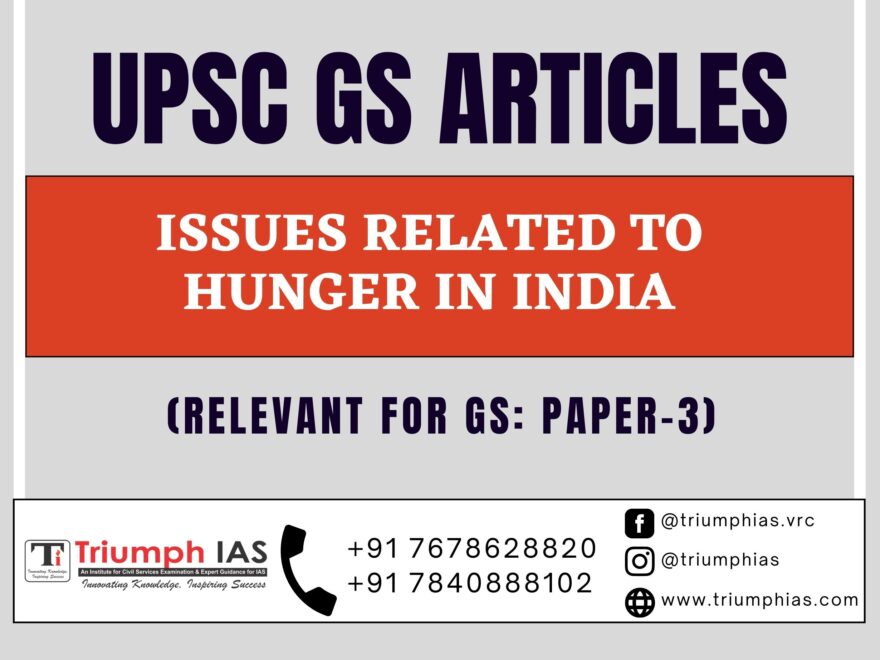ISSUES RELATED TO HUNGER IN INDIA
(Relevant for GS PAPER-3)

Since independence ,India has achieved sufficiency in many fields .It has also achieved sufficiency in food production ,but despite having surplus food, hunger still persists.
What is Hunger?
Hunger is defined as a condition in which a person does not have the physical or financial capability to eat sufficient food to meet basic nutritional needs for a sustained period. In common parlance, hunger refers to discomfort due to a lack of food.
Causes of Hunger
- Poor health services
- Insufficient education and training
- Corruption and warfare
- Environmental degradation
- Inequality
- Population Rise
- Low Productivity in Agriculture
- Under-Utilized Resources
- Low Rate of Economic Development
- Price Rise
- Unemployment
- Shortage of Capital and Able Entrepreneurship
- Social Factors
Survey conducted by NFHS shows that considerable proportion of young children in India face food insecurity, which raises concerns about their development and future well-being. To achieve the Sustainable Development Goal (SDG) 2 of zero hunger, India must take strategic initiatives to eliminate food insecurity and ensure affordable access to nutritious food for all.
Recent survey
- India ranked 107 out of 121 countries in Global hunger index
- Prevalence of undernourishment has also risen in the country from 14.6% in 2018-2020 to 16.3% in 2019-2021
- According to NFHS-5 survey, The zero-food prevalence was 30% for infants aged 6-11 months, 13% among 12-17 months old, and 8% among 18-23 months old children
- Going without food for an entire day at this critical period of a child’s development can have severe implications
Cause of recent paradox in food security
- Poverty is the main cause which restricts food choices and has been the causative factor of hunger related deaths. The persistent high prices of food items and the regional disparities in terms of development affects the people to afford balanced nutrition
- Demographic factors also plays an important role. A person’s ‘nutritional quotient’ is also dependent on demographic factors like gender, caste, age, etc. For instance, the nutritional needs of girl child and elderly are not adequately addressed in our society.
- Poor implementation of policies is also one the main cause
- Changes in climate has affected the food security in india .Climate variability affecting rainfall patterns and agricultural seasons, and climate extremes such as droughts and floods, are among the key drivers behind the rise in hunger, together with conflict and economic slowdowns
- Nutritional deficiency is also one of the cause
Ways to address to problem
- There is need for a national effort to establish routine dietary and nutritional assessments for the entire population
- There is need for adequate availability . Access to adequate and affordable nutritious food is essential for young children for healthy development.
- Developing appropriate food-based metrics to assess food security is essential to evaluate the effectiveness of programs and interventions
- Awareness about government schemes is important. Awareness campaign regarding malnutrition at pan India level is the need of the hour
Food security is most important for India ,which aspires to become a world leader (vishva guru)
Follow us :
-
🔎 https://www.instagram.com/triumphias
🔎https://www.youtube.com/c/TriumphIAS
https://t.me/VikashRanjanSociology
Find More Blogs
Scope of the subject and comparison with other social sciences
Changing family structure in India Modernity and social changes in Europe
Same-Sex Marriage, Marriage Equality, Sociological Perspective, Social Functions of Marriage, Family and Kinship, Supreme Court of India, Special Marriage Act, Petitions, Center, Parliament, Division of Labor, Expressive Role, Task Role, Stability, Dysfunction, Government, Legal System.#Sociologyforupsc #sociologyforupscinhindi #sociologyforupscgs1 #sociologyforupscprelims #sociologyforupscinenglish #sociologyforupscmainsinhindi #sociologyforupscoptionalinhindi #sociologyforupscmains #sociologyforupscplaylist #sociologyforupsclecture1 #sociologyforupsccse #sociologyforupscoptional #syllabusofsociologyforupscoptional #bestbookforsociologyforupsc #sociologyoptionalforupscanswerwriting #sociologyoptionalforupscanukumari #sociologyoptionalforupscabhijeet #sociologyoptionalforupscanalysis #sociologyoptionalforupscalllectures #sociologysyllabusforupscanalysis

